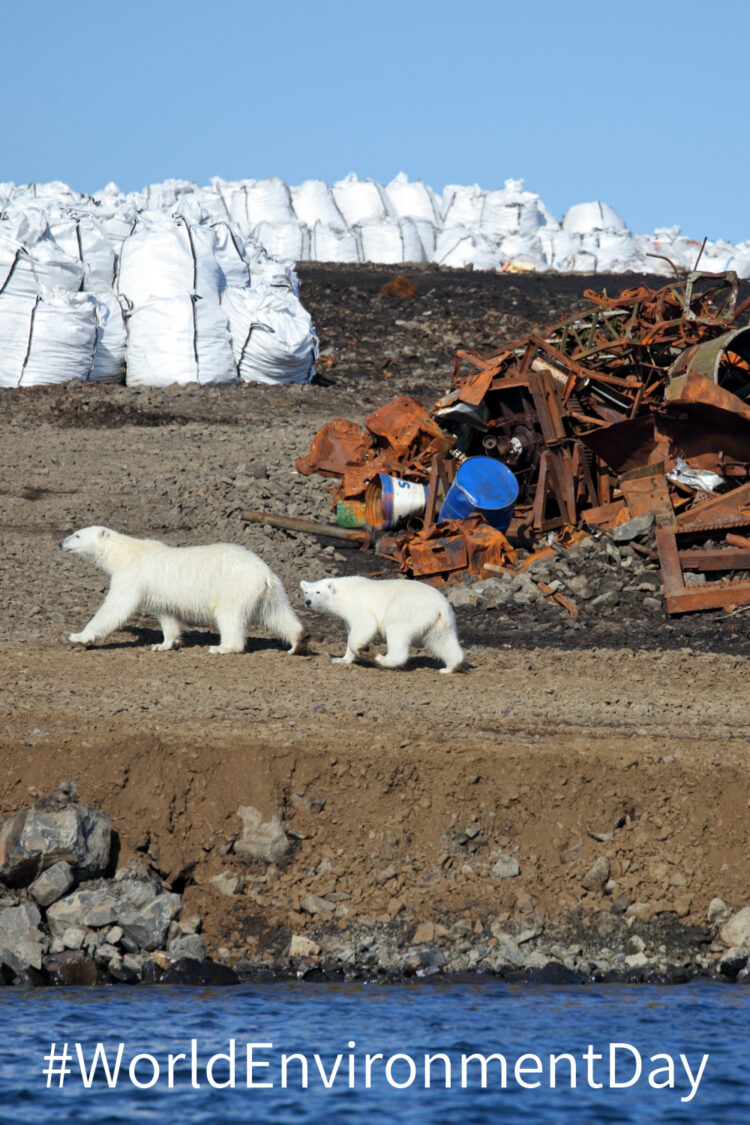 When I started research for Polar: Wildlife at the Ends of the Earth, I knew that Arctic and Antarctic ecosystems are particularly vulnerable to climate change. I didn’t know that they are also particularly vulnerable to pollution. It’s World Environment Day today, so I wanted to share some things about a threat that – I suspect – other people might not know much about either.
When I started research for Polar: Wildlife at the Ends of the Earth, I knew that Arctic and Antarctic ecosystems are particularly vulnerable to climate change. I didn’t know that they are also particularly vulnerable to pollution. It’s World Environment Day today, so I wanted to share some things about a threat that – I suspect – other people might not know much about either.
Plastic Pollution
First, a type of pollution that has received a lot of attention in the media: plastic pollution. Because the world’s oceans are really one big global ocean, plastic has an impact on both polar seas.
Global oceans contain more than 250 million tonnes of plastic waste. More than 200 species of fish, mammals, turtles, and seabirds are known to eat plastic. Seabirds are particularly prone to this odd behaviour, and scientists have identified a possible explanation.
Algae are tiny plants that form the base of the ocean food chain. When krill and other tiny predators eat the algae, the plants release a chemical called DMS. Seabirds in the “tube-nose” family – like prions and petrels – can smell this chemical distress signal. They follow the scent, honing in on patches of ocean that are full of krill and the fish that eat krill. In other words, DMS is a dinner bell for seabirds.
Here’s the connection to pollution. Many commonly-used types of plastic float in seawater. Ocean algae grows on floating plastic – the same algae that release DMS. Less than a month after the plastic hits the water, it smells strongly enough of DMS to attract hungry seabirds. Scientists call this an “olfactory trap,” and estimate that, by 2050, 99% of seabird species will have eaten plastic. The consequences will range from physical blockage of their digestive systems to poisoning as the chemicals in and on plastic are absorbed by their bodies.
Fortunately, plastic pollution has received enough attention in the media that many countries are working to solve the problem. Remembering to bring our reusable bags into the grocery store is a small price to pay to protect petrels.
Shallow Soils and Slow Cycles
Ocean currents carry pollution to both poles. Currents in the atmosphere can have similar effects. For example, smelting of metal ores produces gases and airborne particles that can be carried on the winds. Ice cores taken from Greenland’s glaciers contain lead particles that date between 500 BCE and 300 CE. The lead is four times more concentrated than normal background levels, and was probably produced in Ancient Rome, during the manufacture of lead plumbing pipes. Radioactive particles from the Chernobyl explosion are also detectable in the Arctic, many miles away from their point of origin.
Once pollutants like these arrive in the polar regions, they tend to stick around. That’s because break-down, processing, and nutrient cycling is normally done by bacteria, fungi, and other decomposers… and nature’s recyclers only operate when temperatures are above freezing.
Bioaccumulation
The vast majority of Antarctica stays frozen year round, but summer does come to the Arctic tundra. In peat bogs, rainwater can carry pollutants deeper into the soil than plant roots can reach. But in many areas of the Arctic, rock or permafrost is just a couple inches down. That means pollutants get trapped near the surface, where they are easily absorbed by plants. Once in the plants, they travel to the herbivores. Once in the herbivores, they travel to the carnivores. With every step up the food chain, pollutants become more and more concentrated.
This process is called bioaccumulation. If the pollutant is toxic, bioaccumulation can have devastating effects. For example, bioaccumulation of DDT pushed peregrine falcons – a species that nests in the Canadian Arctic – to the brink of extinction. The chemical interfered with formation of eggshells, and birds laid eggs so fragile that they were crushed under their parents’ bodies. Because of its effect on wildlife, DDT has been banned in North America, and peregrine populations have begun to recover.
Fighting for the Future
Pollution is a bigger problem in the Arctic than Antarctica. That’s partly because more people have lived in the Arctic for much longer, and partly because of the strict international treaties that protect Antarctica from excessive human impacts.
In the Canadian Arctic, mining and oil industries are expanding, raising concerns about impact on fragile habitats. One potential problem is leakage from oil pipelines, as oil is toxic to many arctic plants. Up to 20% of the annual oil production of Russia is thought to be lost through leaky pipelines – a mind-boggling amount.
Human activity is absolutely a problem for the polar regions. But human activity can also be the solution. We’re banning plastic and pollutants like DDT. We took action to reduce acid rain and heal the holes in the ozone layer. This World Environment Day, let’s continue making choices that will protect some of the most vulnerable places on our planet.
Many organizations are working to protect Canada’s Arctic. Visit their websites to learn how you can help:
Ocean’s North: Canada’s Arctic Marine Atlas
WWF: Arctic Species Conservation Fund
Wildlife Conservation Society Canada: Arctic Conservation
Nature Conservancy Canada: Boreal and Arctic